🫨AP BIO Chapter 42 - Ecosystems and Energy
Overview
42.1 Physical laws govern energy flow and chemical cycling in ecosystems
42.2 Energy and other limiting factors control primary production in ecosystems
42.3 Energy transfer between trophic levels is typically only 10% efficient
42.4 Biological and geochemical processes cycle nutrients and water in ecosystems
42.5 Restoration ecologists return degraded ecosystems to a more natural state
BIG IDEAS: All living systems require a constant input of free energy and an exchange of matter with the environment (Big Idea 2). In an ecosystem, energy flows but matter is recycled (Big Idea 4). Multiple strategies exist for managing the transfer of energy and matter within an ecosystem (Big Idea 2)
{{Ecosystem:{{
All the organisms in a given area as well as the abiotic factors with which they interact; one or more communities and the physical environment around them
^^42.1 - Physical laws govern energy flow and chemical cycling in ecosystems^^
An ecosystem consists of all the organisms in a community and the abiotic factors with which they interact. Energy is conserved but degraded to heat during ecosystem processes. As a result, energy flows through ecosystems (rather than being recycled)
Chemical elements enter and leave an ecosystem and cycle within it, subject to the law of conservation of mass. Inputs and outputs are generally small compared to recycled amounts, but their balance determines whether the ecosystem gains or loses an element over time

{{First Law of Thermodynamics:{{
The principle of conservation of energy: Energy can be transferred and transformed, but it cannot be created or destroyed
{{Second Law of Thermodynamics:{{
The principle stating that every energy transfer or transformation increases the entropy of the universe. Usable forms of energy are at least partly converted to heat
Humans use small building block monomers to synthesize things more complex. How does this not break the laws of thermodynamics?
We release energy in the form of heat which increases entropy
{{Law of Conservation of Mass:{{
A physical law stating that matter can change form but cannot be created or destroyed. In a closed system, the mass of the system is constant
{{Autotrophs:{{
An organism that obtains organic food molecules without eating other organisms or substances derived from other organisms. Autotrophs use energy from the sun or from oxidation of inorganic substances to make organic molecules from inorganic ones
{{Primary Producers:{{
An autotroph, usually a photosynthetic organism. Collectively, autotrophs make up the trophic level of an ecosystem that ultimately supports all other levels
{{Heterotrophs:{{
An organism that obtains organic food molecules by eating other organisms or substances derived from them
Trophic levels - Herbivores, which eat plants and other primary producers, are primary consumers. Carnivores that eat herbivores are secondary consumers, and carnivores that eat other carnivores are tertiary consumers

{{Detrivores:{{
A consumer that derives its energy and nutrients from nonliving organic material such as corpses, fallen plant material, and the wastes of living organisms; a decomposer
{{Decomposers:{{
An organism that absorbs nutrients from nonliving organic material such as corpses, fallen plant material, and the wastes of living organisms and converts them to inorganic forms; a detritivore
{{Detritus:{{
Dead organic matter
What’s the importance of decomposers in an ecosystem?
They are interconnected to every trophic level and allow for resources to be recycled
An overview of energy and nutrient dynamics in an ecosystem - Energy enters, flows through, and exits an ecosystem, whereas chemical nutrients cycle within it. Energy (dark orange arrows) entering from the sun as radiation is transferred as chemical energy through the food web; each of these units of energy ultimately exits as heat radiated into space. Most transfers of nutrients (blue arrows) through the food web lead eventually to detritus; the nutrients then cycle back to the primary producers
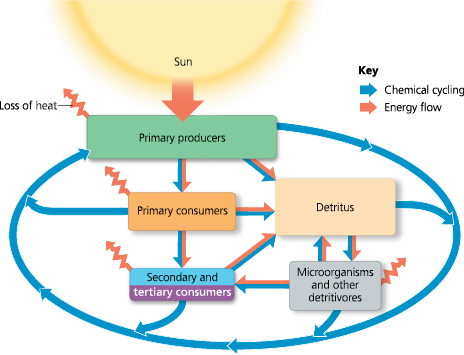
^^Why is the transfer of energy in an ecosystem referred to as energy flow, not energy cycling?^^
Energy passes through an ecosystem, entering as sunlight and leaving as heat. It is not recycled within the ecosystem
^^You are studying nitrogen cycling on the Serengeti Plain in Africa. During your experiment, a herd of migrating wildebeests grazes through your study plot. What would you need to know to measure their effect on nitrogen balance in the plot?^^
You would need to know how much biomass the wildebeests ate from your plot and how much nitrogen was contained in that biomass. You would also need to know how much nitrogen they deposited in urine or feces
^^Use the second law of thermodynamics to explain why an ecosystem’s energy supply must be continually replenished^^
The second law states that in any energy transfer or transformation, some of the energy is dissipated to the surroundings as heat. For the ecosystem to remain intact, this “escape” of energy from the ecosystem must be offset by the continuous influx of solar radiation
^^Considering the second law of thermodynamics, would you expect the typical biomass of primary producers in an ecosystem to be greater than or less than the biomass of secondary producers in the system?^^
Because energy conversions are inefficient, with some energy inevitably lost as heat, you would expect that a given mass of primary producers would support a smaller biomass of secondary producers
^^42.2 - Energy and other limiting factors control primary production in ecosystems^^
Primary production sets the spending limit for the global energy budget. Gross primary production is the total energy assimilated by an ecosystem in a given period. Net primary production, the energy accumulated in autotroph biomass, equals gross primary production minus the energy used by the primary producers for respiration. Net ecosystem production is the total biomass accumulation of an ecosystem, defined as the difference between gross primary production and total ecosystem respiration
In aquatic ecosystems, light and nutrients limit primary production. In terrestrial ecosystems, climatic factors such as temperature and moisture affect primary production at large scales, but a soil nutrient is often the limiting factor locally
{{Primary Production:{{
The amount of light energy converted to chemical energy (organic compounds) by the autotrophs in an ecosystem during a given time period
Why does the total amount of photosynthetic production sets the spending limit for the entire ecosystem’s energy budget?
In most ecosystems, primary producers use light energy to synthesize energy-rich organic molecules, and consumers acquire their organic fuels secondhand (or even third- or fourth-hand) through food webs
{{Gross Primary Production (GPP):{{
The total primary production of an ecosystem
{{Net Primary Production (NPP):{{
The gross primary production of an ecosystem minus the energy used by the producers for respiration
NPP equals
GPP - autotrophic respiration
Global net primary production - This map is based on satellite-collected data, such as amount of sunlight absorbed by vegetation. Note that tropical land areas have the highest rates of production (yellow and red on the map)

^^Does this map accurately reflect the importance of some highly productive habitats, such as wetlands, coral reefs, and coastal zones?^^
The map does not accurately reflect the productivity of wetlands, coral reefs, and coastal zones because these habitats cover areas that are too small to show up clearly on global maps
{{Net Ecosystem Production (NEP):{{
The gross primary production of an ecosystem minus the energy used by all autotrophs and heterotrophs for respiration
NEP equals
GPP - respiration of all organisms
{{Limiting Nutrient:{{
An element that must be added for production to increase in a particular area
List common limiting nutrients
Nitrogen and phosphorus
Pollution from duck farms concentrated near Moriches Bay adds both nitrogen and phosphorus to the coastal water off Long Island, New York. To determine which nutrient limits phytoplankton growth in this area, John Ryther and William Dunstan, of the Woods Hole Oceanographic Institution, cultured the phytoplankton Nannochloris atomus with water collected from several sites, identified as A through G. They added either ammonium (NH4 +) or phosphate (PO43-) to some of the cultures - The addition of ammonium caused heavy phytoplankton growth in the cultures, but the addition of phosphate did not
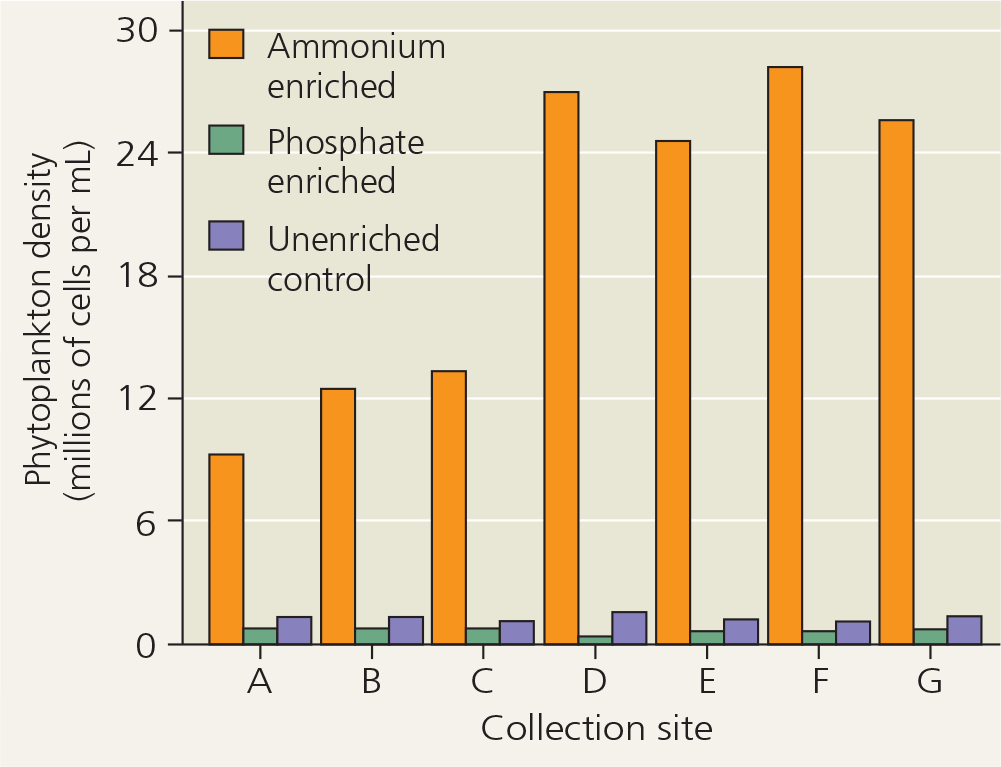
What was the limiting nutrient in the experiment?
The researchers concluded that nitrogen is the nutrient that limits phytoplankton growth in this ecosystem because adding phosphorus did not increase Nannochloris growth, whereas adding nitrogen increased phytoplankton density dramatically
^^Predict how the results would change if water samples were drawn from areas where new duck farms had greatly increased the amount of pollution in the water^^
New duck farms would add extra nitrogen and phosphorus to the water samples used in the experiment. We would expect that the extra phosphorus from these new duck farms would not alter the results (because in the original experiment, phosphorus levels were already so high that adding phosphorus did not increase phytoplankton growth). However, the new duck farms might increase nitrogen levels to the point where adding extra nitrogen in an experiment would not increase phytoplankton density
{{Eutrophication:{{
A process by which nutrients, particularly phosphorus and nitrogen, become highly concentrated in a body of water, leading to increased growth of organisms such as algae or cyanobacteria
A global relationship between net primary production and mean annual precipitation for terrestrial ecosystems
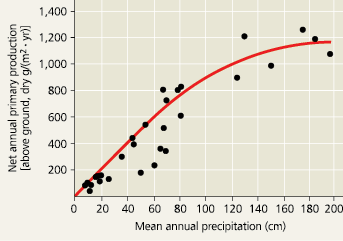
^^Why is only a small portion of the solar energy that strikes Earth’s atmosphere stored by primary producers?^^
Only a fraction of solar radiation strikes plants or algae, only a portion of that fraction is of wavelengths suitable for photosynthesis, and much energy is lost as a result of reflection or heating of plant tissue
^^How can ecologists experimentally determine the factor that limits primary production in an ecosystem?^^
By manipulating the level of the factors of interest, such as phosphorus availability or soil moisture, and measuring responses by primary producers
^^Explain how nitrogen and phosphorus, the nutrients that most often limit primary production, are necessary for the Calvin cycle to function in photosynthesis^^
The enzyme rubisco, which catalyzes the first step in the Calvin cycle, is the most abundant protein on Earth. Like all proteins, rubisco contains nitrogen, and rubisco is so abundant that photosynthetic organisms require considerable nitrogen to make it. Phosphorus is also needed as a component of several metabolites in the Calvin cycle and as a component of both ATP and NADPH
^^If you know NPP, what additional variable do you need to know to estimate NEP? Why might measuring this variable be difficult, for instance, in a sample of ocean water?^^
For estimates of NEP, you need to measure the respiration of all organisms in an ecosystem, not just the respiration of primary producers. In a sample of ocean water, primary producers and other organisms are usually mixed together, making their respective respirations hard to separate
^^42.3 - Energy transfer between trophic levels is typically only 10% efficient^^
The amount of energy available to each trophic level is determined by the net primary production and the production efficiency, the efficiency with which food energy is converted to biomass at each link in the food chain
The percentage of energy transferred from one trophic level to the next, called trophic efficiency, is typically 10%. Pyramids of net production and biomass reflect low trophic efficiency
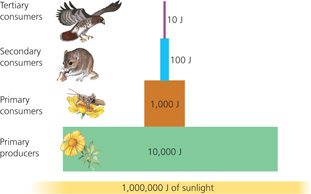
{{Secondary Production:{{
The amount of chemical energy in consumers’ food that is converted to their own new biomass during a given time period
Energy partitioning within a link of the food chain
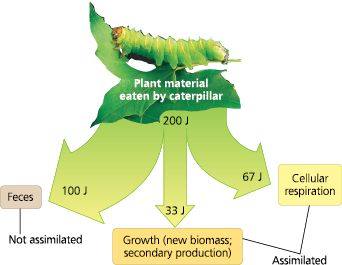
Production efficiency equals
![]()
{{Production Efficiency:{{
The percentage of energy stored in assimilated food that is not used for respiration or eliminated as waste
{{Trophic Efficiency:{{
The percentage of production transferred from one trophic level to the next
What are some reasons energy is lost between trophic levels?
Energy can be lost through cellular respiration, feces, metabolic heat, and unconsumed parts (eat the deer, not the antlers)
{{Energy Pyramid:{{
A chart showing loss of energy in a food chain with the different trophic levels in tiers
An idealized pyramid of energy - This example assumes a trophic efficiency of 10% for each link in the food chain. Notice that primary producers convert only about 1% of the energy available to them to net primary production
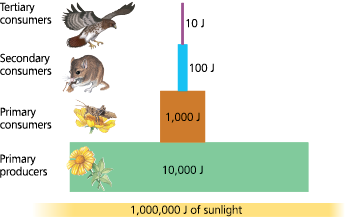
Biomass Pyramids
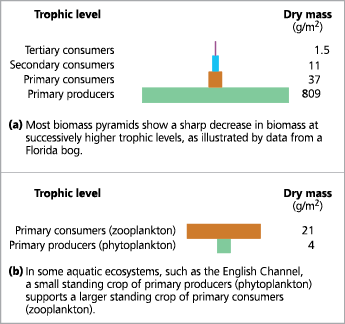
^^If an insect that eats plant seeds containing 100 J of energy uses 30 J of that energy for respiration and excretes 50 J in its feces, what is the insect’s net secondary production? What is its production efficiency?^^
20 J; 40%
^^Tobacco leaves contain nicotine, a poisonous compound that is energetically expensive for the plant to make. What advantage might the plant gain by using some of its resources to produce nicotine?^^
Nicotine protects the plant from herbivores
^^Detritivores are consumers that obtain their energy from detritus. How many joules of energy are potentially available to detritivores in the ecosystem represented in Figure 42.10?^^
Total net production is 10,000 + 1,000 + 100 + 10 J = 11,110 J. This is the amount of energy theoretically available to detritivores
^^Why would runners have a lower production efficiency when running a long-distance race than when they are sedentary?^^
Runners use much more energy in respiration when they are running than when they are sedentary, reducing their production efficiency
^^42.4 - Biological and geochemical processes cycle nutrients and water in ecosystems^^
Water moves in a global cycle driven by solar energy. The carbon cycle primarily reflects the reciprocal processes of photosynthesis and cellular respiration. Nitrogen enters ecosystems through atmospheric deposition and nitrogen fixation by prokaryotes
The proportion of a nutrient in a particular form and its cycling in that form vary among ecosystems, largely because of differences in the rate of decomposition
Nutrient cycling is strongly regulated by vegetation. The Hubbard Brook case study showed that logging increases water runoff and can cause large losses of minerals
Life depends on the recycling of ___
- essential chemical elements
What are some facto that limit primary production and growth of decomposers?
Temperature, moisture, and nutrient availability
Decomposition on land is also slower when conditions are either ___ for decomposers to thrive or _ to supply them with enough oxygen
- too dry; too wet
{{Biogeochemical Cycles:{{
Any of the various chemical cycles that involve both biotic and abiotic components of ecosystems
The water cycle
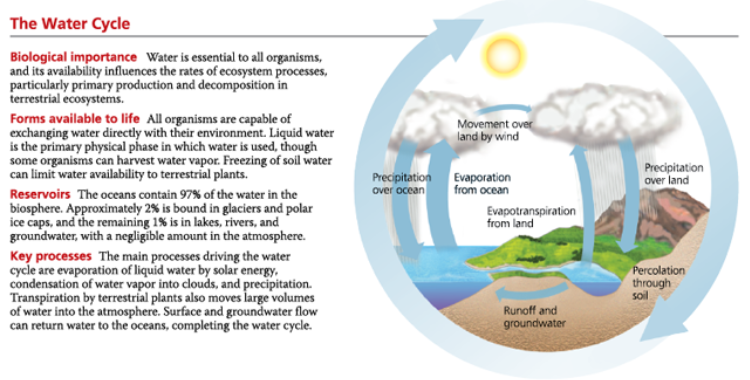
How does transpiration relate to cohesion and intake of gas?
Because water is polar it can bind to the tree cells. As stomata takes in gas, it pulls up water and it leaves
The carbon cycle

The nitrogen cycle
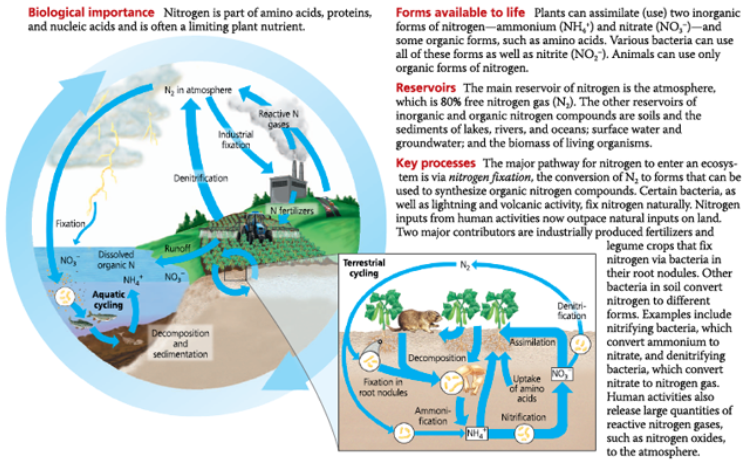
What is made of nitrogen and where does most nitrogen come from?
Amino acids, proteins, nucleic acids, atmosphere
The phosphorus cycle
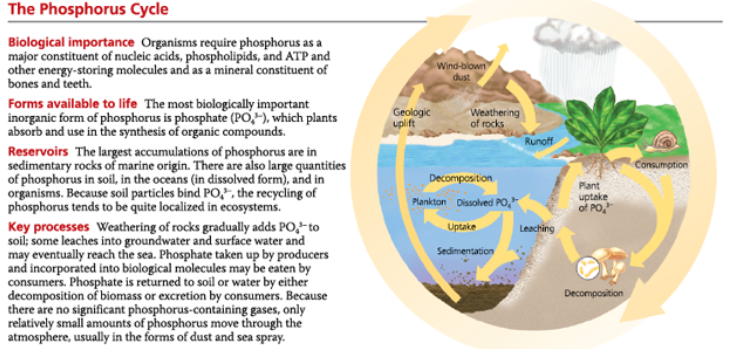
^^For the carbon cycle, draw a simple diagram that shows one possible path for an atom of that chemical from abiotic to biotic reservoirs and back^^
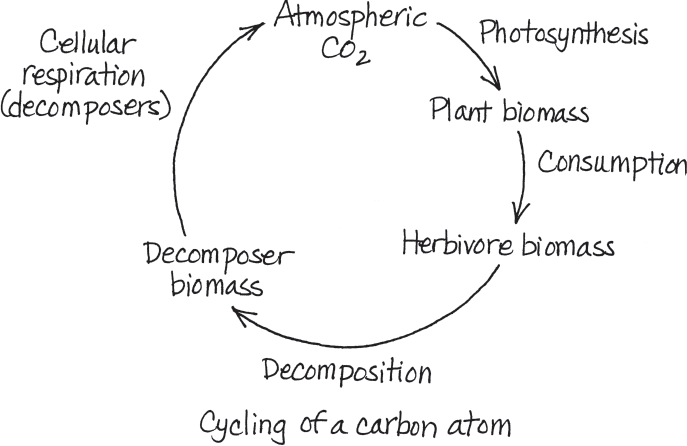
^^Why does deforestation of a watershed increase the concentration of nitrates in streams draining the watershed?^^
Removal of the trees stops nitrogen uptake from the soil, allowing nitrate to accumulate there. The nitrate is washed away by precipitation and enters the streams
^^Why is nutrient availability in a tropical rainforest particularly vulnerable to logging?^^
Most of the nutrients in a tropical rain forest are contained in the trees, so removing the trees by logging rapidly depletes nutrients from the ecosystem. The nutrients that remain in the soil are quickly carried away into streams and groundwater by the abundant precipitation
^^If decomposers usually grow faster and decompose material more quickly in warmer ecosystems, why is decomposition in hot deserts so slow?^^
Factors other than temperature, including a shortage of water and nutrients, slow decomposition in hot deserts
^^42.5 - Restoration ecologists return degraded ecosystems to a more natural state^^
Restoration ecologists harness organisms to detoxify polluted ecosystems through the process of bioremediation
In biological augmentation, ecologists use organisms to add essential materials to ecosystems
How can ecosystems naturally recover from disturbances?
The stages of succession
{{Restoration Ecologists:{{
People who seek to initiate or speed up the recovery of degraded ecosystems
{{Bioremediation:{{
The use of organisms to detoxify and restore polluted and degraded ecosystems
What is commonly used for restoration?
Prokaryotes, plants, and fungi
{{Biological Augmentation:{{
An approach to restoration ecology that uses organisms to add essential materials to a degraded ecosystem
Energy transfer, nutrient cycling, and other key processes for an arctic tundra ecosystem are illustrated
^^Human actions are causing climate change, thereby affecting Earth’s ecosystems—few of which have been affected as greatly as those in the Arctic. Predict whether climate change will cause evolution in arctic tundra populations^^
Populations evolve as organisms interact with each other and with the physical and chemical conditions of their environment. As a result, any human action that alters the environment has the potential to cause evolutionary change. In particular, since climate change has greatly affected Arctic ecosystems, we would expect that climate change will cause evolution in Arctic tundra populations
^^Identify the main goal of restoration ecology.^^
The main goal is to restore degraded ecosystems to a more natural state
^^How do bioremediation and biological augmentation differ?^^
Bioremediation uses organisms, generally prokaryotes, fungi, or plants, to detoxify or remove pollutants from ecosystems. Biological augmentation uses organisms, such two groups that both consume and are consumed by each other are fishes and squids. Figure 41.15 The death of individuals of Mytilus, a dominant species, should open up space for other species and increase species richness even in the absence of Pisaster. Figure 41.23 Other factors not included in the model must contribute to the number of species. Figure 41.24 Shrew populations in different locations and habitats might show substantial genetic variation in their susceptibility to the Lyme pathogen. As a result, there might be fewer infected ticks where shrew populations were less susceptible to the Lyme pathogen and more infected ticks where shrews were more susceptible
^^In preparing a site for surface mining and later restoration, why would engineers separate the topsoil from the deeper soil, rather than removing all soil at once and mixing it in a single pile?^^
If the topsoil and deeper soil are kept separate, the engineers could return the deeper soil to the site first and then apply the more fertile topsoil to improve the success of revegetation and other restoration efforts